Swiss Cheese Plant | Monstera Adansonii | Care Difficulty – Easy

 Add to favorites
Add to favorites
The Swiss cheese plant, also known as Monstera adansonii, gets its name from its large, heart-shaped leaves. As the plant ages, the leaves become covered with holes that resemble Swiss cheese. If you have scanned through the “Plant Variety” category, you will notice a common theme: Care Difficulty – Easy! I don’t have the time or energy to spend on challenging plants. The Swiss cheese plant is very easy to grow, and it loves to climb. If you give it a stake or trellis to grow upward, you’ll enjoy larger leaves with those unique holes.
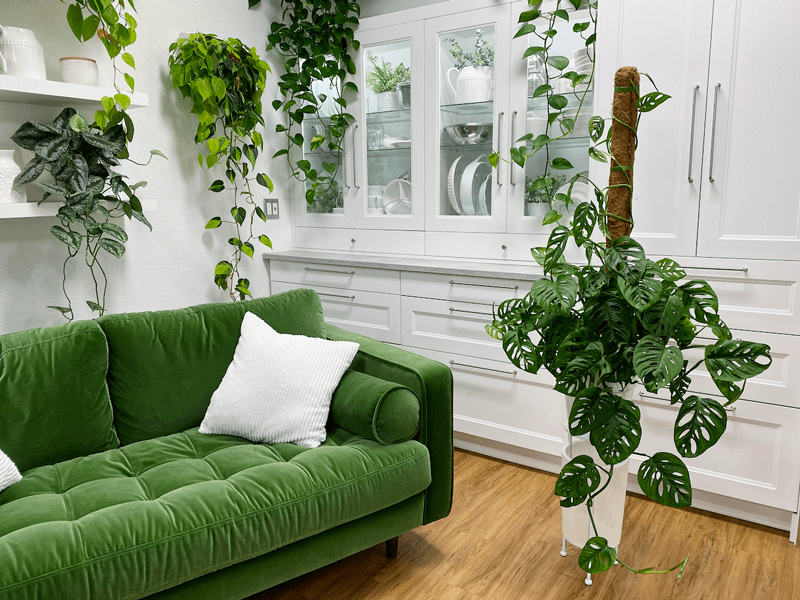
This year for my birthday, my husband surprised me with a Swiss cheese plant, and trust me, that was no easy task, especially when dwelling in a very small community. He called our local florist to see if they could order one in. It just so happened that they were heading into their plant provider warehouse to pick up their order that very next day. Gina was excited to find one for me. Not only did they find one, but they also delivered it the very next day!
Once I was done drooling over the charm of this plant, I noticed that the soil was SOAKED and the plant was “tight.”
-
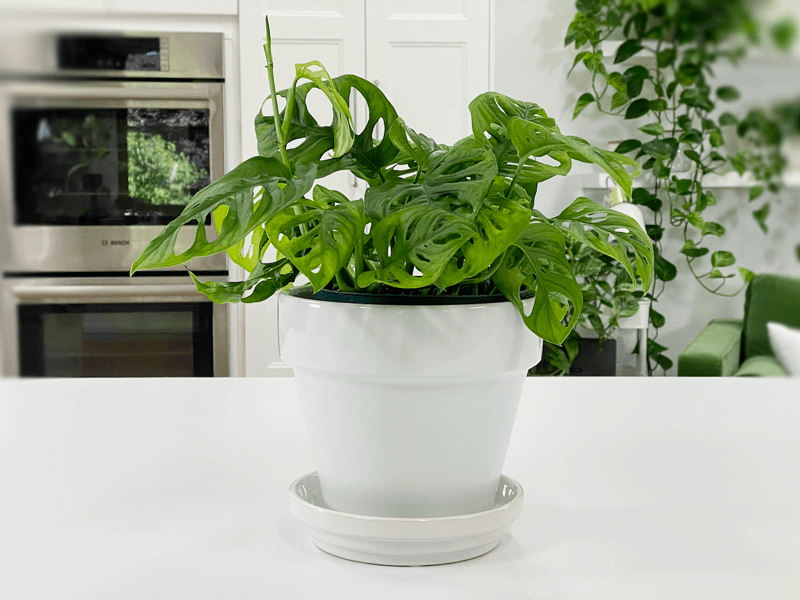
-
Growth from July 30th, 2020
-
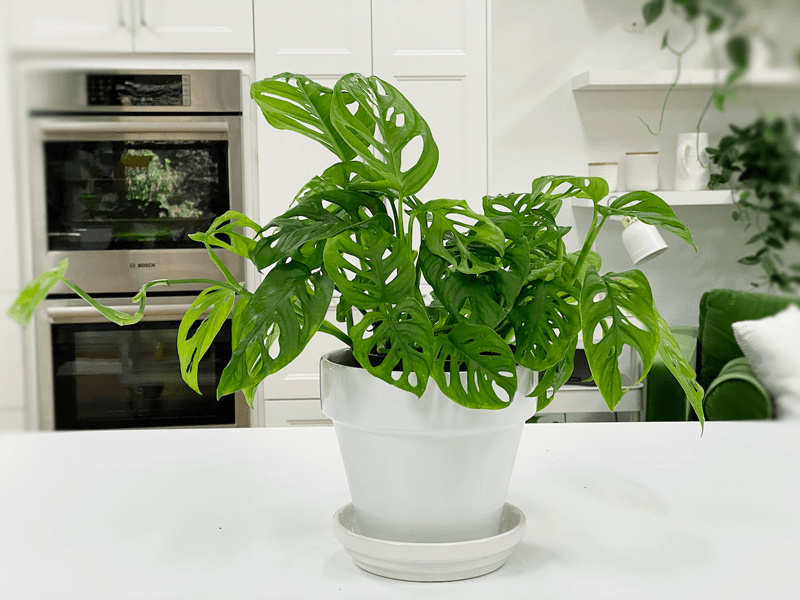
-
to October 3rd, 2020
The Swiss cheese plant is part of the Monstera family. I have several Monstera deliciosa plants, and if you click on the link you will see that these plants share a similar characteristic — oval-shaped holes or fenestrations dappled throughout the leaves. But one of the differences is that the Monstera deliciosa fenestrations create openings on the edges of the leaves, whereas the Monstera adansonii (Swiss cheese) leaves do not. If you notice that the fenestrations are open along the edges on some leaves of a Swiss cheese plant, that can happen with mishandling or transport, or sometimes I have witnessed new spikes of leaf growth that push up into the hole of another leaf, and in time, it gets torn.
-
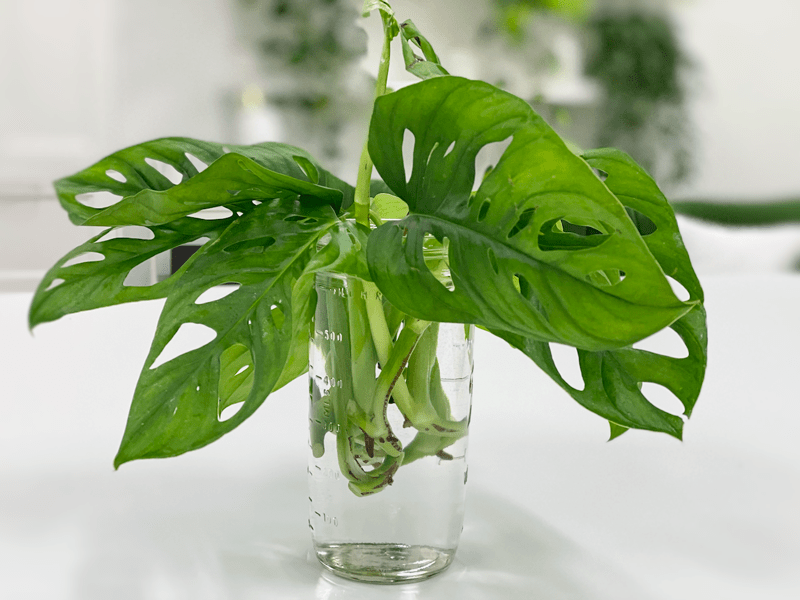
-
Water propagation started August 8th, 2020
-
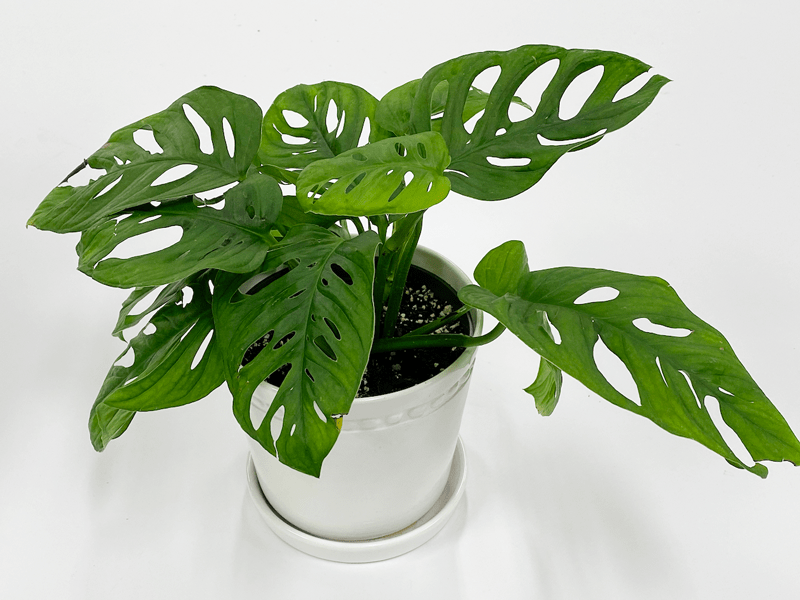
-
Once rooted, transferred to soil.
Characteristics of the Swiss Cheese Plant
- This plant is a vining plant, which you can train to go up on a pole, or the vines can hang naturally like a pothos plant.
- There are two forms that are differentiated called the Monstera adansonii Round Form and the Monstera adansonii Narrow Form.
- The narrow form leaves are usually more elongated, and their tips point slightly to one side.
- The round form has the same holes in the leaves as the narrow form but is wider and more heart-shaped.
- Interesting fact: Many scientists believe that the leaves are filled with holes due to the fact that they have to compete with other plants to gain sunlight. This adaptation allows the plant to cover more area while not wasting energy on a fully developed leaf blade.
- One thing to keep an eye one… new growth starts off as a “spear” and if positioned just right, they can push up in the holes of an upper leaf, possibly tearing it in time. So, it’s a good habit to check your plant to make sure this doesn’t happen.
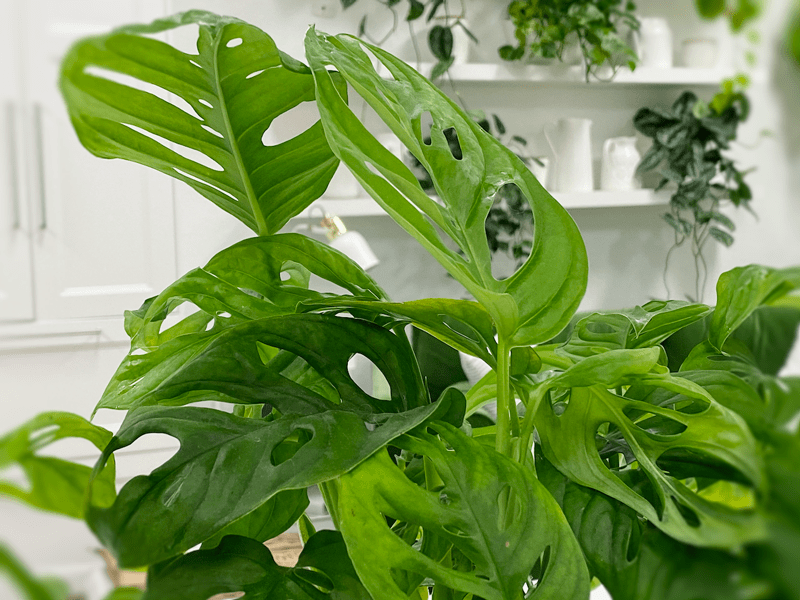
Light Requirements
I have found that they grow best in bright, indirect light, or partial shade light. In my observation, I have noticed that if the plant isn’t getting enough life the new leaves are waiting to unfurl end up with brown edges, and don’t fully open. At first, I thought this was a watering issue but I did several tests and found that the Swiss Cheese Plants that I put in brighter lite areas, the leaves unfurled beautifully. Just something to keep tucked away. I currently have a large Swiss Cheese Plant in an east-facing window and it is flourishing.
Temperature Requirements
Like most plants, they prefer rooms kept at a temperature between 64 – 81 degrees (F). That’s a pretty wide range, so find what keeps you both comfortable. Anything below 64 degrees can cause your plant growth to slow down and possibly kill the plant if exposed for too long.
Water Requirements
Water every 1-2 weeks, allowing soil to dry out between waterings. The timing will be affected by the time of the year, your ambient temp, etc. I find that I water less in the winter. It will also depend on the placement of your plant, you can expect to water more often in brighter light and less often in lower light. When watering add enough water until the excess runs out of the bottom of the pot, so make sure the pot has plenty of drainage holes in the bottom.
Humidification Requirements
Keep the room anywhere between an average or high humidity for the happiest plant. Cold and hot temperatures can often affect humidity levels in our homes, so if you feel the change in your skin or hair, or you are walking around shocking everyone (and not with just your beauty), you might want to look into a home humidifier. I personally use the LEVOIT Humidifier which can easily handle spaces as large as 753 ft.
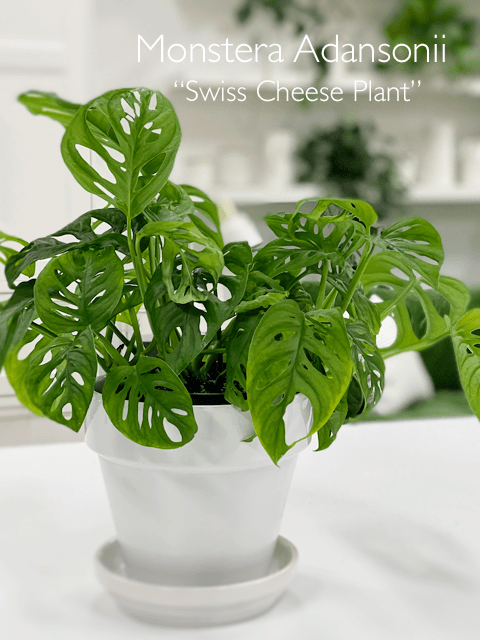 Plant Characteristics to Watch For
Plant Characteristics to Watch For
Diagnosing what is going wrong with your plant is going to take a little detective work, but even more patience! First of all, don’t panic and don’t throw out a plant prematurely. Take a few deep breaths and work down the list of possible issues. Below, I am going to share some typical symptoms that can arise. When I start to spot troubling signs on a plant, I take the plant into a room with good lighting, pull out my magnifiers, and begin by thoroughly inspecting the plant.
The leaves are turning yellow.
- Yellow leaves can be a sign that your plant lacks nutrients or it is being overwatered.
The leaves are curling and/or turning brown around the edges.
- Curled leaves and brown leaf edges can be a result of too little water and overexposure to the sun.
- Solution: First, start off by checking out the watering routine that you use for this plant. If you sense that the plant is receiving ample water, then let’s look at the location in which it lives. Bright, direct light can cast harsh rays on the plant, which will show up as signs of being sun-scorched. You will either need to relocate the plant or hang a sheer over the window to filter the light.
The leaf tips are browning with yellow halos.
- Too low humidity can cause browning leaf tips with yellow halos.
- Solution: Increase humidification by adding a room humidifier, or set the plant pot on a tray lined with pebbles and water.
Why are the leaves losing their dark-green color and becoming pale?
- The loss of color is often caused by too much light or possibly too little fertilizer.
- Solution: If you feel that you are properly fertilizing the plant, check to make sure the plant is out of the direct sun. There shouldn’t be any sunbeams coming down on it.
I wish my leaves were larger.
- Those who want to have a Monstera adansonii with larger leaves and more dynamic perforations can provide a trellis or a stake for the plant to climb.
The leaves are drooping and/or have dark brown to black spots on the lower leaves.
- Often, this is a sign that the soil is staying too damp, which can lead to root rot, which leads to bacteria and fungus. Unfortunately, this causes the plant to droop because the damaged roots can’t absorb water for the leaves and stems, so the effect is similar to the soil being too dry–leaves get no water.
- Solution: This condition is treatable if caught early.
- Remove the plant from the pot and rinse as much of the soil off the roots as you can. If they appear to be rotting, trim the roots that are smelly, soft, mushy, and/or darker in color.
- Make sure that the pot you are returning the plant to has drainage holes. If you are going to use the same pot that it was in originally, be sure to clean it with bleach and water first to kill off any bacteria or fungus that the decaying may have caused.
- Repot the plant in fresh soil that is well-draining. You can add perlite, pumice stone, or bark to the soil mix to ensure this.
- Now water the soil with a mix of 1 tablespoon of hydrogen peroxide per cup of water. Peroxide releases oxygen and acts as an oxygen supplement for plants. It seems to really support both good health and strong growth for plants. Hydrogen peroxide can also help with soil fungus.
- **Keep in mind that they need less water when the weather gets cooler, so you might not need to give it the same amount of water in the winter as you do in the heat of summer.
The leaves on my plant are folded or shriveled.
- Leaves that are folded or shriveled is an indicator that the soil is too dry.
- Solution: Water the plant slowly until water starts to drip out of the drainage pot. See “watering requirements” up above.
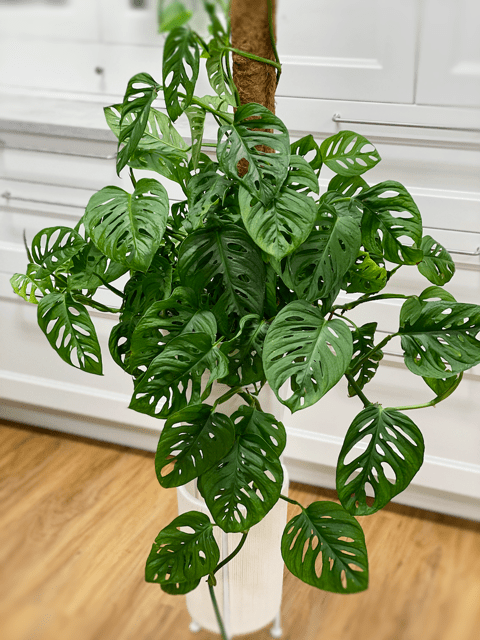 The new leaves are not unfurling (opening up).
The new leaves are not unfurling (opening up).
- The most common reason for delayed leaf unfurling is lack of humidity, but it can also be a lack of patience on your end. I say that from experience.
- Solution: Supplement with a room humidifier. If there’s still no change, double-check the lighting and the temperatures that the plant is being exposed to. Remember, diagnosing plant symptoms takes time, so don’t expect dramatic changes with a couple of days.
The leaves don’t have holes in them.
- Newer leaves will have fewer holes than those that are more developed. Young plants often have no holes in the leaves. The leaves will emerge as the plant matures. When new leaves emerge, they will be a fresh and bright green and will darken to when mature.
I would love a fuller-looking plant.
- To create a fuller-looking plant, pruning is the ticket. Take some cuttings from your longest stems. You’ll want to cut either side of where the leaf joins the stem (in the same way that you would propagate a pothos plant) using a sterile scissor. Not only will this force new bushier growth, but it will give you some leaves to propagate, giving you more plant babies.
- If patience isn’t one of your superpowers, you can take rooted cuttings and plant them in the same pot as the mother plant.
When I water my plant, the water rushes right through and out the drain holes.
- This can be a sign that the plant is root-bound, which prevents the water from soaking all of the soil/roots. Without the ability to get the water and nutrients it needs, this plant won’t grow to its full potential.
- Solution: Gently remove the plant from the pot and check out the root system. If the roots are circling the plant, chances are that it is root-bound.
Additional Care
- Remove yellow or dying leaves, and plant debris, to encourage better growing conditions and to reduce pests who are attracted to decaying matter. While pruning, always use clean scissors to reduce the chance of bacterial and fungal diseases.
- Clean the leaves often enough to keep dust off. This is especially important if the plant is in a lower-light location. Due to the holes in the leaves, it is best to clean the leaves with a shower of water. You can do this in the kitchen sink with a hand sprayer, or if it’s too big for that, do it in the tub or outside with a hose (weather permitting).
- Avoid using commercial leaf-shining products on this plant.
-
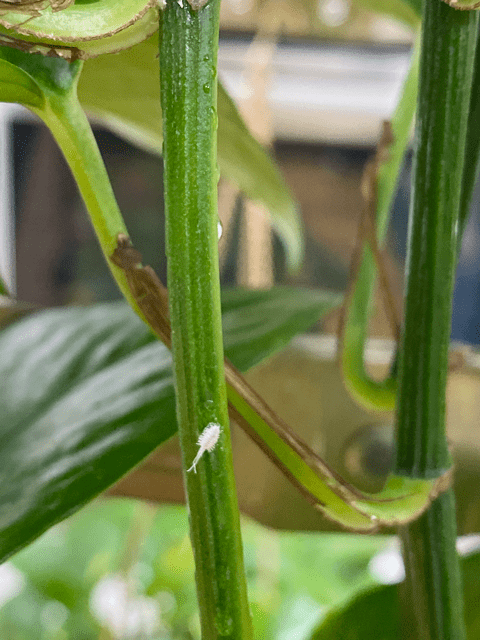
-
Mealybugs
-
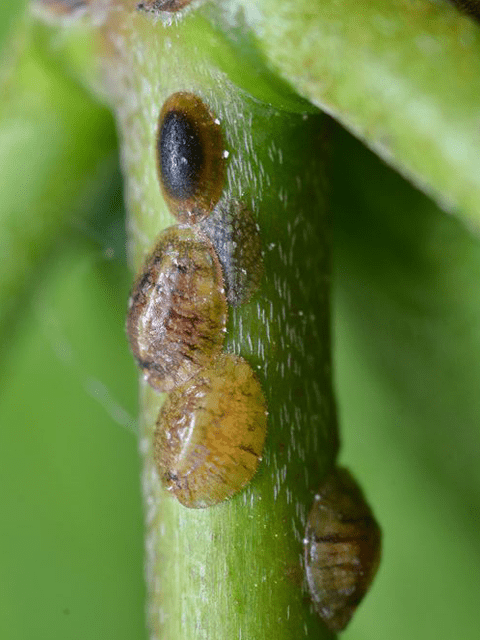
-
Scales
-
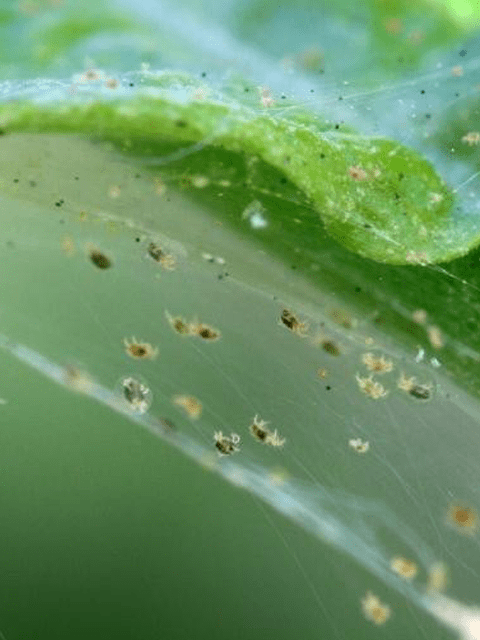
-
Spider mites
Common Bugs to Watch For
If you want to have healthy houseplants, you MUST inspect them regularly. Every time I water a plant, I give it a quick look-over. Bugs/insects feeding on your plants reduces the plant sap and redirects nutrients from leaves. Some chew on the leaves, leaving holes in the leaves. Also watch for wilting or yellowing, distorted, or speckled leaves. Pests can quickly get out of hand and spread to your other plants.
IF you see ONE bug, trust me, there are more. So, take action right away. Some are brave enough to show their “faces” by hanging out on stems in plan sight. Others tend to hide out in the darnedest of places, like the crotch of a plant or in a leaf that has yet to unfurl.
- Mealybugs look like small balls of cotton. They can travel, slowly, but they have a strong will and determination! Though they are slow-moving, if any plant is touching another, there is a chance the mealybug will hitch a ride on a new leaf and spread. They breed like rabbits of the insect world. Females can deposit around 600 eggs in loose cottony masses, often on the underside of leaves or along stems.
- Scales are dark-colored bumps that are primarily immobile insects that stick themselves to stems and leaves. They are rather inconspicuous and don’t look like a typical insect. They can range in color but are most often brownish in appearance. They’re called “scales” primarily due to their scale-like appearance on a plant, due to waxy or armored coverings. They are often seen in clumps along a stem, sucking away at the plant’s juices with their spiky mouthpart.
- Spider mites are more common on houseplants. They are not insects – they are related to spiders. These appear to be tiny black or red moving dots. Spider mites are nearly invisible to the naked eye. You often need a magnifying lens to spot them, or you may just notice a reddish film across the bottom of the leaves, some webbing, or even some leaf damage, which usually results in reddish-brown spots on the leaf.
Toxicity
According to the ASPCA, the Monstera adansonii is considered to be moderately toxic when it comes to your pets. If eaten, they can have a number of adverse reactions such as vomiting, swallowing problems, or oral irritation. If your pet tends to chew on leaves around the house, keep your Monstera out of their way.
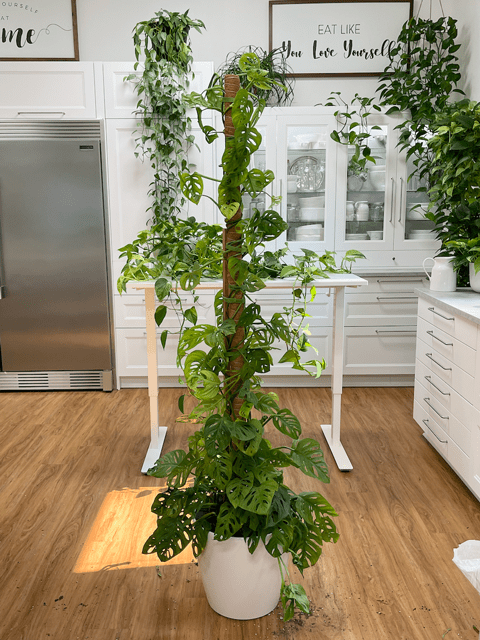
6/30/21 – Here is an update photo of the plant shown up top which was from 10/03/20. I up-potted it and added a total of 70″ of moss pole to it. Shew!
© AmieSue.com
Tags: Care Difficulty - Easy, Low Light, Medium - Bright Light


 Add to favorites
Add to favorites


 Plant Characteristics to Watch For
Plant Characteristics to Watch For The new leaves are not unfurling (opening up).
The new leaves are not unfurling (opening up).
hi there. you didn’t explain what lighting is best for this plant. can you add that?
Oh goodness, how did I skip over that?! I updated the post. Thanks for pointing this out. blessings, amie sue
Easily the best and most thorough write up on my fenestrated friend! For so long I have wondered abt the two different subtypes and the plant I had. Thank you;))
Awe thanks Sassy plant lady :) I LOVE the Swiss cheese plant. I have several and they add such interest to a space. Enjoy and have a blessed day, amie sue
Do the leaves of your plants have a slight variation of green? Not vieragated just a little lighter? After buying one I was reading on the care and was panicking thinking I bought a plant with mosaic virus.
Good morning Cathy,
Boy, it’s really hard for me to say since I can’t see the plant, etc. I do have leaves that are slightly different in color but I think that has to do with either the newness or maturity of that particular leaf. Can you go back to the place that you bought it from and have them diagnose it for you? I wish you the best. Diagnosing plant issues is like asking an infant if their tummy hurts. Good luck, amie sue
Hi! You mentioned that when you got the plant, it was soaked and tight. The one I just bought is the same as you described. What did you do after? Did you wait to repot until the soil dries out a bit or repot right away?
Does it loosen up eventually and what exactly causes the tightness?
Thanks!
Good day Veronique,
I am sorry that you ran into the same situation, I am sure that it’s a unique occurrence. I ended up repotting mine in fresh soil. It was just so overwatered that I feared root rot. Once repotted I waited a few days before I watered it. The tightness was due to it being on the verse of root-bound. So when I removed the wet heavy soil, I carefully worked my fingers in the soil and roots to gently separate them. I couldn’t get all of it out of fear of damaging the plant but in the end, the plant did very well and continues to grow. I hope this helps, blessings. amie sue
Interesting! I also got my Swiss cheese plant and it was very tight and oversaturated. It has been a few weeks and I have not repotted it yet. It is loosening up some, but my new growth is still tightly furled and not opening… Would you mist to increase humidity to help with that?
I wanted to ask about lighting, you mentioned yours in an east-facing, as is mine, about 3 feet from the window. It’s generally a bright room, and a “sun patch” passes over the plant for an hour or two. Do yours get any direct light?
Thanks for the info, this is a great article – detailed and well-organized!
Good day Lisa,
Swiss cheese plants can be tricky. I will get tightly curled new growth that either takes forever to open or it starts to die. I pinch them off when they start to do that. I don’t mist my Swiss Cheese plant. As far as adding humidity, it all depends on what your living environment is like. If it’s really dry you can supplement with a humidifier. It won’t hurt.
As far as light goes, none of my plants get DIRECT light, it’s all indirect or filtered. Direct light can burn the plants (depending on intensity). Right now, I have a large Swiss Cheese plant that is in the center of a room with medium light and it’s doing great.
I hope this helps, blessings. amie sue
How do you root off of your existing plant?
Thanks,
Tina
Good day Tina,
Are you familiar with propagating pothos plants? If so, it’s the exact same steps. If you’ve never propagated a plant before these are the following steps:
1. Start by using a clean, disinfected pair of pruning shears or scissors.
2. Select a vine that has healthy leaves on it.
3. Remove part of the stem a minimum of four inches long, right below a leaf node (where the leaf meets the stem).
Cut at a 45° angle to increase surface area. If you have a really long vine that you want to remove from the mother plant, you can make a cut on the stem between each
leaf. A node is ALWAYS required for propagating, this is where the root will grow from.
4. Place each cutting in a jar/glass of water, making sure that the node is submerged and the leaf is in the air. Filtered water is best, as the chemicals in tap water
may hinder growth, but it’s not a necessity.
5. If you have a pothos plant, take a cutting from it and place it in the same jar as the Swiss cheese plant cuttings… a pothos cutting helps other plants grow roots.
but you don’t have to do this, just a trick of the trade.
6. Place the jar where the leaves will receive indirect sunlight.
7. Maybe once a week change out the water and keep an eye on the water level, topping it off as needed.
8. Once the roots form (about 2-3″ long) you can move onto transferring to soil.
I hope this helps. If you have any further questions, please reach out. blessings, amie sue
How can I root a cutting from a Swiss cheese plant?
What kind of skill the plant needs? DIY recipe
Good morning Adelya,
The Swiss cheese plant fits in the aroid category, which means that they like nutrient-dense soil that holds moisture yet doesn’t remain soggy. I use a combination of (equal parts): pumice, orchid bark, coco coir chips, and perlite.
I then add in a few large handfuls of coco peat, vermiculite, horticultural charcoal, worm castings (if I have it on hand) and potting soil.
I don’t adhere to a set-in-stone recipe, but these are the basic ingredients I will use. The main thing is not to stress about being exact in measurements or the exact ingredients. Sometimes due to lack of availability, I might skip using one of the barks, etc. The main thing that aroid plant needs is aeration, some moisture retention, and nutrients.
*Pumice stones – great for aeration, don’t break down, lightweight
*Orchid bark- great for quick draining yet moisture retentive soil
*Coco coir chips – regulate the aeration of the growing medium and maintain the ideal air-to-moisture ratio for the plant roots.
*Perlite – It is porous, allowing it to hold air pockets to allow drainage and breathability to your soil. It can also retain water
long enough for even water dispersion into the soil.
Add in’s
*Coco peat – It provides both nutrients and aeration to the plant and is great to use along an orchid bark mix to provide nutrition to
the plant.
*Vermiculite – It helps to aerate the soil while simultaneously retaining water and nutrients. It also acts as a magnet for nutrients
and slowly re-releases them back into the soil, adding to the growing cycle. It also adds some weight to the pot, so plants won’t
tobble over.
*Horticultural charcoal – It absorbs impurities and stabilizes the soil pH.
*Worm castings – Worm castings provide an all-natural, 100% organic, highly effective fertilizer that will not burn your plants. I
don’t always use this but I try to.
*Indoor houseplant potting soil – Provides just enough moisture retention and the perfect amount of nutrients for your plant.
I hope this helps! amie sue
I would love to know the information about the pot and the misspoke you have yours in! Love the set up especially for a smaller space.
Thank you!
Good day Tarah,
As far as the standard pots I use, they are just random ones I pick up when I am out shopping. I keep all my plants in nursery pots, so they drain water, but then I slide them into a cover pot. All of mine are white to keep the look uniform, plus I think the white really makes the greenery pop! The moss poles that I used for this plant were ones that were ordered from Amazon. They come in certain lengths and are made so you can add on to them as the plant grows. These are the ones I used: https://www.amazon.com/dp/B08X7JBB1Q/?tag=nouraw-20.
I hope this helps. blessings, amie sue
Beautiful!!!!! I want one but have pets. Very dangerous to any pet!
I live in an in-law basement apartment “Temporarily 2yrs max” in Boston and just bought a Swiss Cheese plant, this past summer I had my plants outside but moved them inside due to the Northeast winters, so I use a few Full Spectrum LED plant lights, What would you suggest as far as where I place the plant with the lights? Do I need to avoid placing the plant directly under the light or would it do better with more direct led lighting?
Good morning Sean,
I don’t use a lot of grow lights myself, but the ones I do operate range from 1′-3′ away from my plants in general. A lot of it will also depend on the type of light you are using, how far the light spreads, etc. Best of luck, amie sue
Hi wonderful post thank you, I don’t believe I saw where you discussed proper watering?
Thanks for letting me know Gabi. All taken care of..
Water Requirements
Water every 1-2 weeks, allowing the soil to dry out between waterings. The timing will be affected by the time of the year, your ambient temp, etc. I find that I water less in the winter. It will also depend on the placement of your plant, you can expect to water more often in brighter light and less often in lower light. When watering add enough water until the excess runs out of the bottom of the pot, so make sure the pot has plenty of drainage holes in the bottom.
Blessings and have a wonderful week, amie sue
Hello I have a Swiss cheese plant and I was wondering what do I do to get rid of the bugs just want to know ahead of time so I will be prepared
I would like to know what’s the best thing to do if your plants happen to be attacked by the bugs that you mentioned above just want to be prepared thanks
Hello Gloria,
At the bottom of the post, I discuss the insects to watch for. Different plants attract different bugs, so understanding that knowing what they look for, and how to treat them will give you a hand up on the situation. I have a section that goes over some of the most common insects that you can read about here- https://nouveauraw.com/indoor-plants/plant-pests/. I also have another section on plant care. https://nouveauraw.com/indoor-plants/plant-care/
You will find a lot of good information there to have you armed for whatever may come your way.
blessings, amie sue
Hi beautiful plant and love the moss pole. Do you keep the pole watered as well? Or leave it dry. Does this one have a wood stake and if so are you worried about it rotting in the soil? Or getting moldy?
Hello Caroline,
I don’t water this moss pole. I make another kind of pole, creating a pole that is filled with moss and coconut bark. I water that one. It does have a wood stake but I am not worried about it rotting or getting moldy. The plant would need transplanting before the wood ever rotted. At least that’s been the case for me. And as far as it getting moldy, if it does get moldy, I feel it would be do to overwatering the plant and not letting the soil dry out some. I hope this helps, amie sue
I have a Swiss cheese plant with small leaves. It was doing very well and then all the leaves fell off. The vines are healthy looking, but bare. I took some cuttings to start over and they are rooting. But what happened? Thanks for any help.
Hello Sheryl,
It’s too hard to say since I can’t see the plant nor do I know its history of care. Swiss cheese plants can be real finicky. The main things to think about is: the placement (type of light it was getting, was it located near air vents), was it watered properly, were there any signs of insects, and were you fertilizing it? Diagnosing plants is job that requires patience and time. I wish I could give you a more straight forward answer. Best of luck! amie sue
I have this a plant at my office, the vines are 25-30 ft long but not many leaves. What should I do?
Hello Becca,
I see this a lot. I would cut the vine. Start at the base of the vine and follow it, as soon as you hit the bare spot, cut it. You can propagate the vine you removed and by cutting it off, it will signal new growth. It’s painful at times to make such cuts but no new leaves will grow in those bare spots. Often times, these long stretches with no leaves on it can be cause by low light… the plant is stretching for light. So double-check the placement of the plant as well. Best of luck, amie sue
Enjoyed reading this article. Concise and easy to understand. Beautiful pictures!
Thank you for the feedback Enny :)
I have a swiss cheese plant that is about 55 yrs old, I bought him in 1972. Anyway, I have it in the correct lighting, gets watered every 2 weeks, I mist it once a month, it is in a pot approx 20″ wide by 16″ deep. It does not look good, the leaves do not get big and do not split. Anyone have any suggestions
Gosh Marlene, after having that plant for 52 years in your care… you would know more about it then I would. :) Is it suffering in any way or is it that the leaves aren’t slitting for you? Has it recently been up-potted? Moved? etc. Plant investigation takes a lot of patience and trouble shooting. It’s hard for me to really know without knowing more. blessings, amie sue
Not related to the post, but where did you get that couch?
Hi Alexis,
I got it here: https://www.article.com/product/24751/sven-88-tufted-velvet-sofa-plush-pacific-green?srsltid=AfmBOorElY-5VO90JHAzpIwsF8MMhgtyDem-NcwgI8PLa9KggdmwflQQ
amie sue